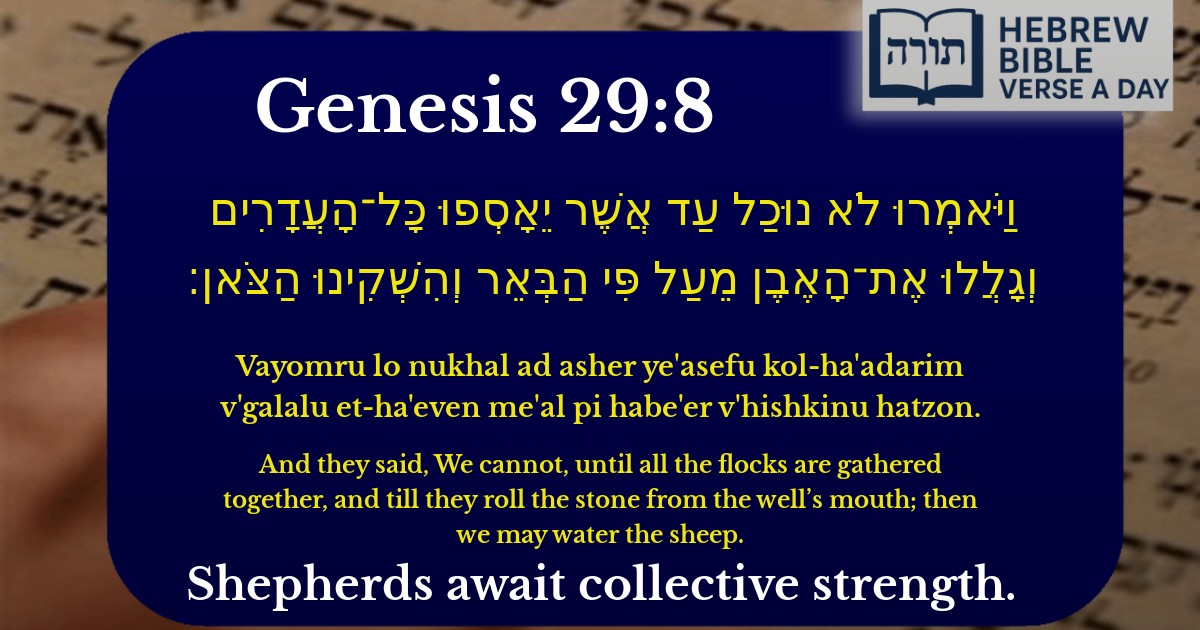Join Our Newsletter To Be Informed When New Videos Are Posted
Join the thousands of fellow Studends who rely on our videos to learn how to read the bible in Hebrew for free!
Hebrew Text
וַיֹּאמְרוּ לֹא נוּכַל עַד אֲשֶׁר יֵאָסְפוּ כָּל־הָעֲדָרִים וְגָלֲלוּ אֶת־הָאֶבֶן מֵעַל פִּי הַבְּאֵר וְהִשְׁקִינוּ הַצֹּאן׃
English Translation
And they said, We cannot, until all the flocks are gathered together, and till they roll the stone from the well’s mouth; then we may water the sheep.
Transliteration
Vayomru lo nukhal ad asher ye'asefu kol-ha'adarim v'galalu et-ha'even me'al pi habe'er v'hishkinu hatzon.
Hebrew Leining Text
וַיֹּאמְרוּ֮ לֹ֣א נוּכַל֒ עַ֣ד אֲשֶׁ֤ר יֵאָֽסְפוּ֙ כׇּל־הָ֣עֲדָרִ֔ים וְגָֽלְלוּ֙ אֶת־הָאֶ֔בֶן מֵעַ֖ל פִּ֣י הַבְּאֵ֑ר וְהִשְׁקִ֖ינוּ הַצֹּֽאן׃
Parasha Commentary
📚 Talmud Citations
This verse is not quoted in the Talmud.


Context in the Torah
The verse (Bereshit 29:8) appears in the narrative of Yaakov's arrival in Charan, where he encounters shepherds at a well. The shepherds explain that they cannot water their flocks until all the flocks are gathered and the stone covering the well is rolled away. This sets the stage for Yaakov's meeting with Rachel, where he single-handedly rolls the stone away to water her sheep.
Rashi's Explanation
Rashi (Bereshit 29:8) explains that the shepherds could not remove the stone on their own because it was exceedingly heavy. The phrase "עַד אֲשֶׁר יֵאָסְפוּ כָּל־הָעֲדָרִים" ("until all the flocks are gathered") implies that the stone was placed there as a communal safeguard—only when all the shepherds were present could they combine their strength to remove it. This prevented any individual from drawing water without the others.
Symbolism of the Stone
The Midrash (Bereshit Rabbah 70:8) suggests that the stone symbolizes the obstacles in Yaakov's path to fulfilling his destiny. Just as he single-handedly removed the stone—a feat normally requiring many—so too would he overcome future challenges through divine assistance. The well itself is interpreted as a metaphor for Torah (as in Mishlei 5:15, "Drink waters from your own well"), and the stone represents the barriers to accessing divine wisdom.
Halachic Implications
Rambam (Hilchos Gezeilah Va'Avedah 10:5) derives from this episode a principle of communal property rights: just as the shepherds jointly protected the well's water, communities may establish regulations (תקנות הקהל) to manage shared resources. The stone acted as a physical גדר (fence) to prevent misuse, reflecting the Torah's emphasis on fair and collective stewardship.
Moral Lessons